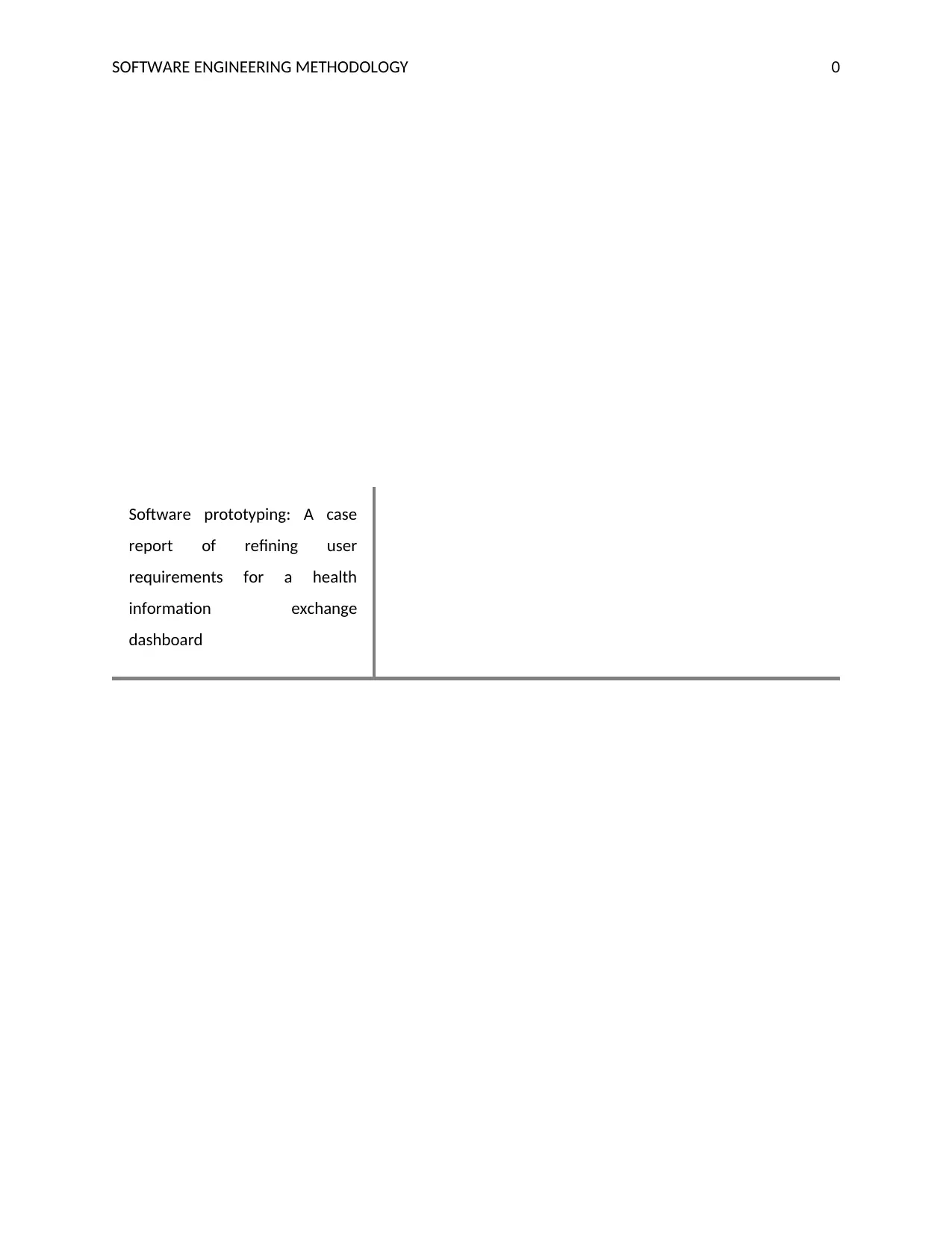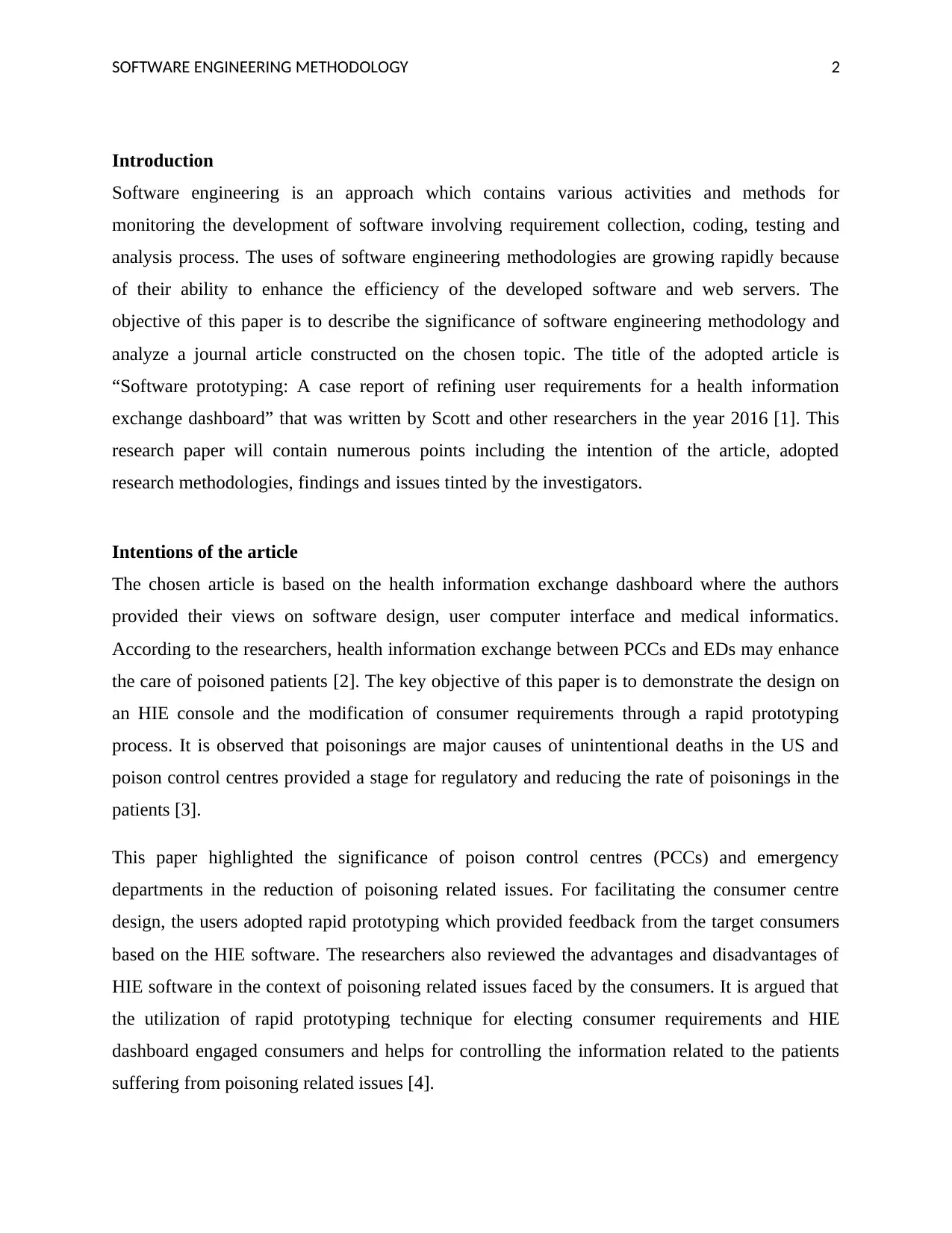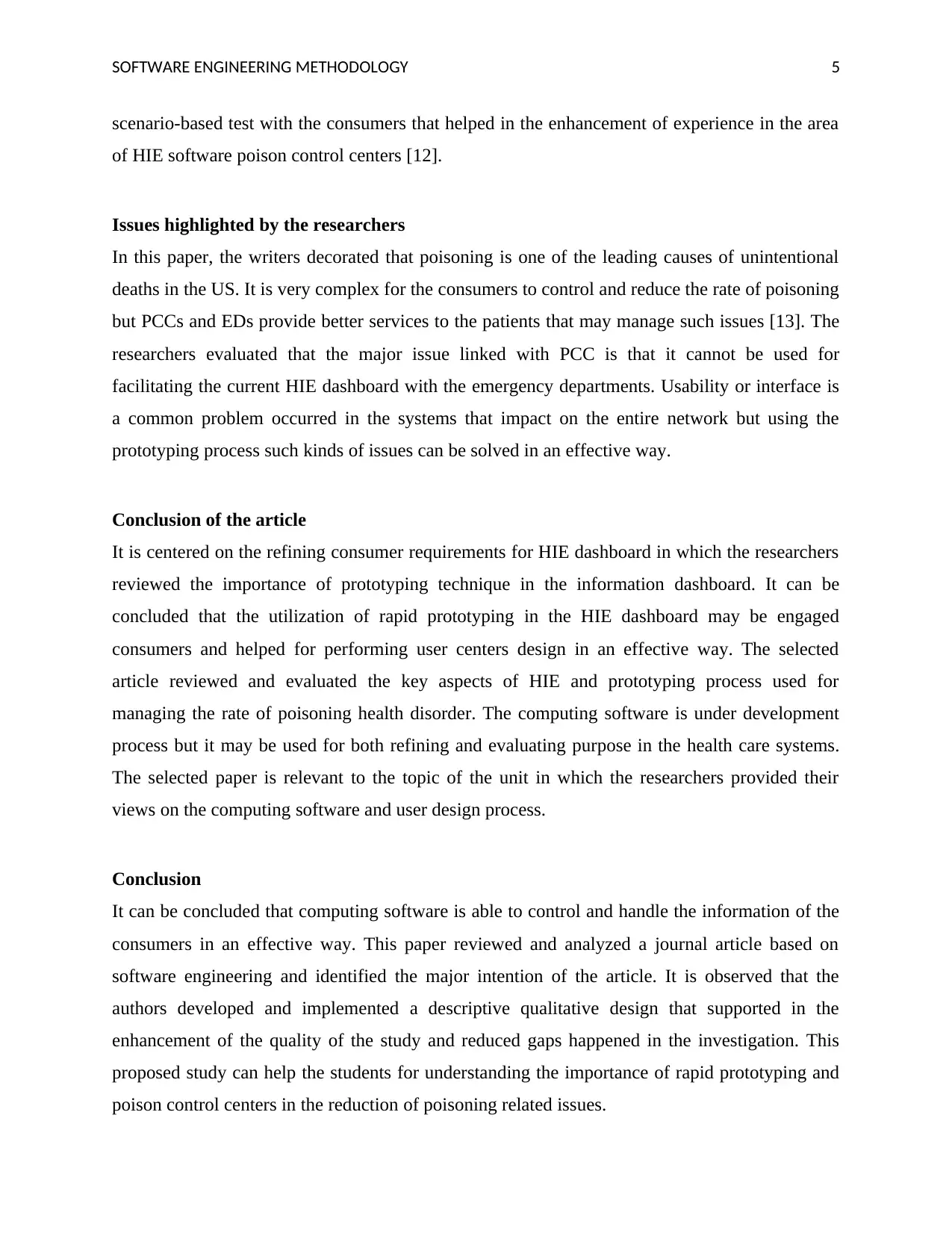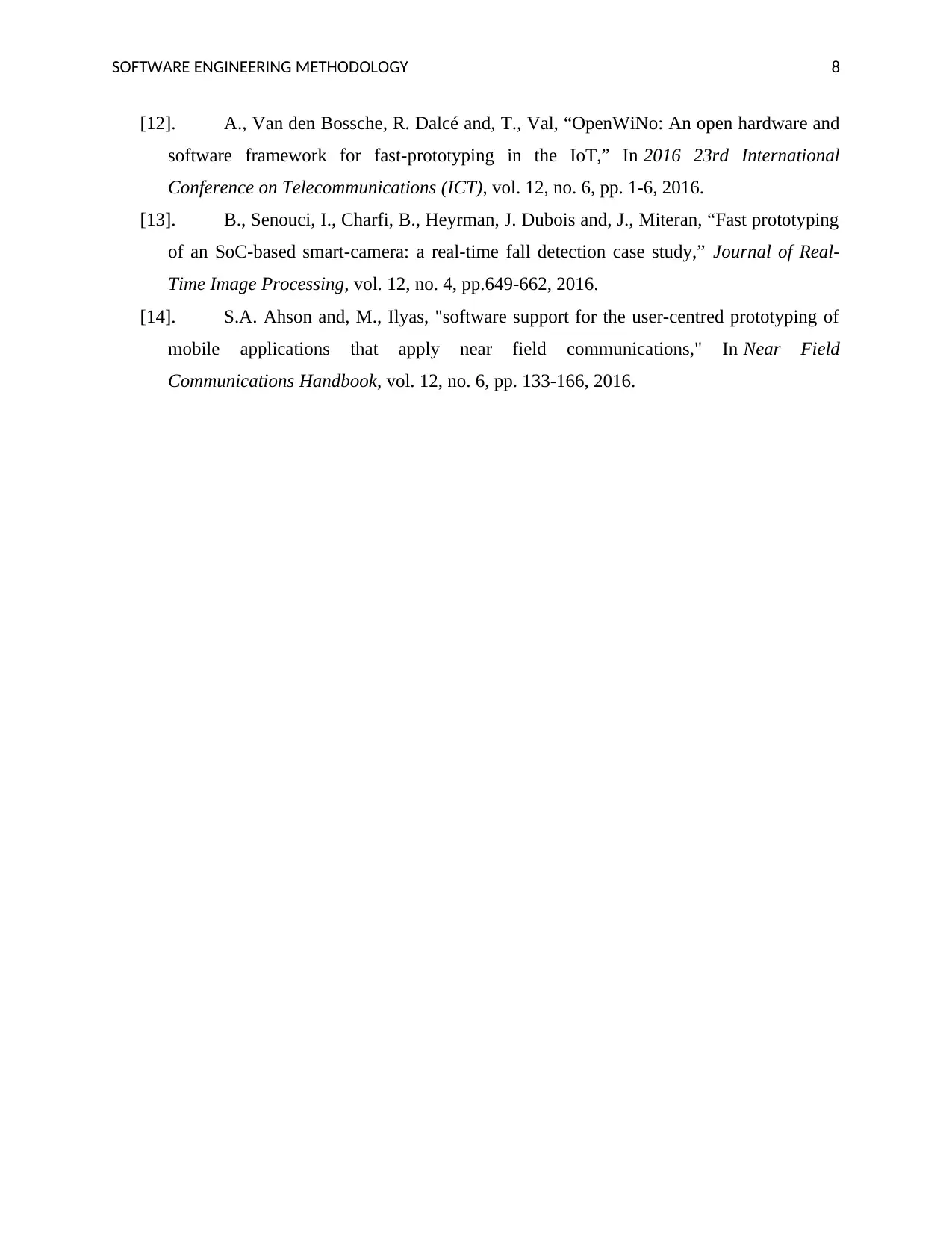Software Engineering Methodology: Refining User Requirements Report
VerifiedAdded on 2022/11/09
|9
|2250
|218
Report
AI Summary
This report analyzes a case study titled "Software prototyping: A case report of refining user requirements for a health information exchange dashboard." The assignment delves into the significance of software engineering methodologies, particularly in the context of healthcare, and analyzes a journal article by Scott et al. The study focuses on the design of a Health Information Exchange (HIE) dashboard and the refinement of user requirements through rapid prototyping. The article explores the importance of Poison Control Centers (PCCs) and Emergency Departments (EDs) in managing poisoning-related issues and highlights the use of rapid prototyping to gather user feedback and improve the HIE dashboard. The research employed a mixed research design, incorporating both qualitative and quantitative methods, and utilized data collection methods such as case studies and literature reviews. The findings emphasize the need for specialized software to facilitate HIE between PCCs and EDs, and the importance of user-centered design in developing effective systems. The report concludes that the use of rapid prototyping is crucial for engaging consumers and improving the usability of the HIE dashboard, ultimately contributing to better patient care.

SOFTWARE ENGINEERING METHODOLOGY 0
Software prototyping: A case
report of refining user
requirements for a health
information exchange
dashboard
Software prototyping: A case
report of refining user
requirements for a health
information exchange
dashboard
Paraphrase This Document
Need a fresh take? Get an instant paraphrase of this document with our AI Paraphraser

SOFTWARE ENGINEERING METHODOLOGY 1
Table of Contents
Introduction......................................................................................................................................2
Intentions of the article....................................................................................................................2
Research methodologies..................................................................................................................3
Research design............................................................................................................................3
Data collection methods...............................................................................................................4
Data analysis................................................................................................................................4
Findings and results of the study.....................................................................................................4
Issues highlighted by the researchers..............................................................................................5
Conclusion of the article..................................................................................................................5
Conclusion.......................................................................................................................................5
References........................................................................................................................................7
Table of Contents
Introduction......................................................................................................................................2
Intentions of the article....................................................................................................................2
Research methodologies..................................................................................................................3
Research design............................................................................................................................3
Data collection methods...............................................................................................................4
Data analysis................................................................................................................................4
Findings and results of the study.....................................................................................................4
Issues highlighted by the researchers..............................................................................................5
Conclusion of the article..................................................................................................................5
Conclusion.......................................................................................................................................5
References........................................................................................................................................7

SOFTWARE ENGINEERING METHODOLOGY 2
Introduction
Software engineering is an approach which contains various activities and methods for
monitoring the development of software involving requirement collection, coding, testing and
analysis process. The uses of software engineering methodologies are growing rapidly because
of their ability to enhance the efficiency of the developed software and web servers. The
objective of this paper is to describe the significance of software engineering methodology and
analyze a journal article constructed on the chosen topic. The title of the adopted article is
“Software prototyping: A case report of refining user requirements for a health information
exchange dashboard” that was written by Scott and other researchers in the year 2016 [1]. This
research paper will contain numerous points including the intention of the article, adopted
research methodologies, findings and issues tinted by the investigators.
Intentions of the article
The chosen article is based on the health information exchange dashboard where the authors
provided their views on software design, user computer interface and medical informatics.
According to the researchers, health information exchange between PCCs and EDs may enhance
the care of poisoned patients [2]. The key objective of this paper is to demonstrate the design on
an HIE console and the modification of consumer requirements through a rapid prototyping
process. It is observed that poisonings are major causes of unintentional deaths in the US and
poison control centres provided a stage for regulatory and reducing the rate of poisonings in the
patients [3].
This paper highlighted the significance of poison control centres (PCCs) and emergency
departments in the reduction of poisoning related issues. For facilitating the consumer centre
design, the users adopted rapid prototyping which provided feedback from the target consumers
based on the HIE software. The researchers also reviewed the advantages and disadvantages of
HIE software in the context of poisoning related issues faced by the consumers. It is argued that
the utilization of rapid prototyping technique for electing consumer requirements and HIE
dashboard engaged consumers and helps for controlling the information related to the patients
suffering from poisoning related issues [4].
Introduction
Software engineering is an approach which contains various activities and methods for
monitoring the development of software involving requirement collection, coding, testing and
analysis process. The uses of software engineering methodologies are growing rapidly because
of their ability to enhance the efficiency of the developed software and web servers. The
objective of this paper is to describe the significance of software engineering methodology and
analyze a journal article constructed on the chosen topic. The title of the adopted article is
“Software prototyping: A case report of refining user requirements for a health information
exchange dashboard” that was written by Scott and other researchers in the year 2016 [1]. This
research paper will contain numerous points including the intention of the article, adopted
research methodologies, findings and issues tinted by the investigators.
Intentions of the article
The chosen article is based on the health information exchange dashboard where the authors
provided their views on software design, user computer interface and medical informatics.
According to the researchers, health information exchange between PCCs and EDs may enhance
the care of poisoned patients [2]. The key objective of this paper is to demonstrate the design on
an HIE console and the modification of consumer requirements through a rapid prototyping
process. It is observed that poisonings are major causes of unintentional deaths in the US and
poison control centres provided a stage for regulatory and reducing the rate of poisonings in the
patients [3].
This paper highlighted the significance of poison control centres (PCCs) and emergency
departments in the reduction of poisoning related issues. For facilitating the consumer centre
design, the users adopted rapid prototyping which provided feedback from the target consumers
based on the HIE software. The researchers also reviewed the advantages and disadvantages of
HIE software in the context of poisoning related issues faced by the consumers. It is argued that
the utilization of rapid prototyping technique for electing consumer requirements and HIE
dashboard engaged consumers and helps for controlling the information related to the patients
suffering from poisoning related issues [4].
⊘ This is a preview!⊘
Do you want full access?
Subscribe today to unlock all pages.

Trusted by 1+ million students worldwide

SOFTWARE ENGINEERING METHODOLOGY 3
In this generation, the rate of poisoning is growing rapidly and many individuals are suffering
from serious injuries but PCCs are able to reduce the rate of poisoning in an effective manner. In
this generation, PCC systems are not mainly developed for facilitating HIEs with emergency
departments so; the researchers are designing effective software and computing systems in order
to help the integration of technology at the programming code level [5]. The researchers also
included the opinions of other investigators for better understanding the research concerns and
reducing the conflicts occurred in the study.
This research paper provided a way of controlling and reducing the rate of poisoning and
understanding the significance of HIE software and PCCs systems [6]. The HIE dashboard
allows SPIs in the poison control centres in order to monitor the health-related issues faced by
the consumers. Moreover, such kind of process also enables SPIs for sending consultation notes
to the patients’ assessment and recommendations for health care providers in the emergency
departments [7].
Research methodologies
It is characterized as a procedure which is principally used in the examination for dealing with
the development of data. With the assistance of research techniques, the scientists can without
much of a stretch find and break down the dependable actualities identified with the exploration
subject [14]. There are various research systems used by the analysts which will be portrayed in
this area.
Research design
It is a key piece of the technique that helped the scientists for executing the powerful theory of
the examination. In this diary paper, the analysts embraced a blended research structure which
includes subjective and quantitative techniques. From the past examination, it is discovered that
subjective structure gives hypothetical certainties identified with the product advancement
process while quantitative plan centre around the numerical information accumulated from the
past investigations [5]. It is analyzed that the utilized such sort of configuration is increasingly
successful and dependable which aided the authorities for regulatory and tending to the holes
happened in the inspection. Utilizing both subjective and quantitative strategies the creators had
the option to build up the fitting inquiries of the examination [8].
In this generation, the rate of poisoning is growing rapidly and many individuals are suffering
from serious injuries but PCCs are able to reduce the rate of poisoning in an effective manner. In
this generation, PCC systems are not mainly developed for facilitating HIEs with emergency
departments so; the researchers are designing effective software and computing systems in order
to help the integration of technology at the programming code level [5]. The researchers also
included the opinions of other investigators for better understanding the research concerns and
reducing the conflicts occurred in the study.
This research paper provided a way of controlling and reducing the rate of poisoning and
understanding the significance of HIE software and PCCs systems [6]. The HIE dashboard
allows SPIs in the poison control centres in order to monitor the health-related issues faced by
the consumers. Moreover, such kind of process also enables SPIs for sending consultation notes
to the patients’ assessment and recommendations for health care providers in the emergency
departments [7].
Research methodologies
It is characterized as a procedure which is principally used in the examination for dealing with
the development of data. With the assistance of research techniques, the scientists can without
much of a stretch find and break down the dependable actualities identified with the exploration
subject [14]. There are various research systems used by the analysts which will be portrayed in
this area.
Research design
It is a key piece of the technique that helped the scientists for executing the powerful theory of
the examination. In this diary paper, the analysts embraced a blended research structure which
includes subjective and quantitative techniques. From the past examination, it is discovered that
subjective structure gives hypothetical certainties identified with the product advancement
process while quantitative plan centre around the numerical information accumulated from the
past investigations [5]. It is analyzed that the utilized such sort of configuration is increasingly
successful and dependable which aided the authorities for regulatory and tending to the holes
happened in the inspection. Utilizing both subjective and quantitative strategies the creators had
the option to build up the fitting inquiries of the examination [8].
Paraphrase This Document
Need a fresh take? Get an instant paraphrase of this document with our AI Paraphraser

SOFTWARE ENGINEERING METHODOLOGY 4
Data collection methods
It is assessed that the creators included both essential and optional information-gathering
strategies which are increasingly fitting for the examination. For the most part, essential
information and actualities were gathered utilizing contextual analyses and meetings led by the
writers however auxiliary information was gathered utilizing writing survey and diary articles
[6]. Along these lines, it is accounted for that utilizing such sorts of strategies the creators kept
up the holes happened in the examination and furthermore upgraded the nature of the
investigation [14]. Besides, there are various sources included for social occasion optional
information, for instance, past papers, diary article, online books, etc. Utilizing these techniques,
the creators gathered solid realities and information from the individuals that aided in the
accomplishment of the objectives of the examination [10].
Data analysis
It is one of the viable techniques of the exploration that give a method for examining and
assessing the gathered data identified with the product advancement systems. It is discovered that
the analysts incorporated an elucidating factual strategy for breaking down the information or
certainties identified with programming advancement [7]. In addition, the creators additionally
received SPSS apparatuses for acquiring the solid results of the examination. In this way,
embraced inquire about strategies and procedures are proper as far as examination that
additionally bolstered the creators for keeping up holes between the examination concerns and
gathered data [13].
Findings and results of the study
It is found that poison control centres are not developed for facilitating HIE with emergency
departments for which specialized software was developed in order to support HIE within the
normal workflow of the PCC [11]. The conducted survey with the consumers provided effective
feedbacks related to the HIE dashboard and developed system and managed the issue of
poisoning in the patients. This research paper shows a theoretical framework about the poisoning
problem and examined the significance of PCCs and EDs in the context of poisoning health
issue. In this article, the authors designed an interactive high fidelity prototype and developed the
Data collection methods
It is assessed that the creators included both essential and optional information-gathering
strategies which are increasingly fitting for the examination. For the most part, essential
information and actualities were gathered utilizing contextual analyses and meetings led by the
writers however auxiliary information was gathered utilizing writing survey and diary articles
[6]. Along these lines, it is accounted for that utilizing such sorts of strategies the creators kept
up the holes happened in the examination and furthermore upgraded the nature of the
investigation [14]. Besides, there are various sources included for social occasion optional
information, for instance, past papers, diary article, online books, etc. Utilizing these techniques,
the creators gathered solid realities and information from the individuals that aided in the
accomplishment of the objectives of the examination [10].
Data analysis
It is one of the viable techniques of the exploration that give a method for examining and
assessing the gathered data identified with the product advancement systems. It is discovered that
the analysts incorporated an elucidating factual strategy for breaking down the information or
certainties identified with programming advancement [7]. In addition, the creators additionally
received SPSS apparatuses for acquiring the solid results of the examination. In this way,
embraced inquire about strategies and procedures are proper as far as examination that
additionally bolstered the creators for keeping up holes between the examination concerns and
gathered data [13].
Findings and results of the study
It is found that poison control centres are not developed for facilitating HIE with emergency
departments for which specialized software was developed in order to support HIE within the
normal workflow of the PCC [11]. The conducted survey with the consumers provided effective
feedbacks related to the HIE dashboard and developed system and managed the issue of
poisoning in the patients. This research paper shows a theoretical framework about the poisoning
problem and examined the significance of PCCs and EDs in the context of poisoning health
issue. In this article, the authors designed an interactive high fidelity prototype and developed the

SOFTWARE ENGINEERING METHODOLOGY 5
scenario-based test with the consumers that helped in the enhancement of experience in the area
of HIE software poison control centers [12].
Issues highlighted by the researchers
In this paper, the writers decorated that poisoning is one of the leading causes of unintentional
deaths in the US. It is very complex for the consumers to control and reduce the rate of poisoning
but PCCs and EDs provide better services to the patients that may manage such issues [13]. The
researchers evaluated that the major issue linked with PCC is that it cannot be used for
facilitating the current HIE dashboard with the emergency departments. Usability or interface is
a common problem occurred in the systems that impact on the entire network but using the
prototyping process such kinds of issues can be solved in an effective way.
Conclusion of the article
It is centered on the refining consumer requirements for HIE dashboard in which the researchers
reviewed the importance of prototyping technique in the information dashboard. It can be
concluded that the utilization of rapid prototyping in the HIE dashboard may be engaged
consumers and helped for performing user centers design in an effective way. The selected
article reviewed and evaluated the key aspects of HIE and prototyping process used for
managing the rate of poisoning health disorder. The computing software is under development
process but it may be used for both refining and evaluating purpose in the health care systems.
The selected paper is relevant to the topic of the unit in which the researchers provided their
views on the computing software and user design process.
Conclusion
It can be concluded that computing software is able to control and handle the information of the
consumers in an effective way. This paper reviewed and analyzed a journal article based on
software engineering and identified the major intention of the article. It is observed that the
authors developed and implemented a descriptive qualitative design that supported in the
enhancement of the quality of the study and reduced gaps happened in the investigation. This
proposed study can help the students for understanding the importance of rapid prototyping and
poison control centers in the reduction of poisoning related issues.
scenario-based test with the consumers that helped in the enhancement of experience in the area
of HIE software poison control centers [12].
Issues highlighted by the researchers
In this paper, the writers decorated that poisoning is one of the leading causes of unintentional
deaths in the US. It is very complex for the consumers to control and reduce the rate of poisoning
but PCCs and EDs provide better services to the patients that may manage such issues [13]. The
researchers evaluated that the major issue linked with PCC is that it cannot be used for
facilitating the current HIE dashboard with the emergency departments. Usability or interface is
a common problem occurred in the systems that impact on the entire network but using the
prototyping process such kinds of issues can be solved in an effective way.
Conclusion of the article
It is centered on the refining consumer requirements for HIE dashboard in which the researchers
reviewed the importance of prototyping technique in the information dashboard. It can be
concluded that the utilization of rapid prototyping in the HIE dashboard may be engaged
consumers and helped for performing user centers design in an effective way. The selected
article reviewed and evaluated the key aspects of HIE and prototyping process used for
managing the rate of poisoning health disorder. The computing software is under development
process but it may be used for both refining and evaluating purpose in the health care systems.
The selected paper is relevant to the topic of the unit in which the researchers provided their
views on the computing software and user design process.
Conclusion
It can be concluded that computing software is able to control and handle the information of the
consumers in an effective way. This paper reviewed and analyzed a journal article based on
software engineering and identified the major intention of the article. It is observed that the
authors developed and implemented a descriptive qualitative design that supported in the
enhancement of the quality of the study and reduced gaps happened in the investigation. This
proposed study can help the students for understanding the importance of rapid prototyping and
poison control centers in the reduction of poisoning related issues.
⊘ This is a preview!⊘
Do you want full access?
Subscribe today to unlock all pages.

Trusted by 1+ million students worldwide

SOFTWARE ENGINEERING METHODOLOGY 6
Paraphrase This Document
Need a fresh take? Get an instant paraphrase of this document with our AI Paraphraser

SOFTWARE ENGINEERING METHODOLOGY 7
References
[1]. S.D., Nelson, G., Del Fiol, H., Henseler, B.I. Crouch and, M.R., Cummins, “Software
prototyping,” Applied clinical informatics, vol. 7, no. 01, pp.22-32, 2016.
[2]. T.J., Ranney, M.L., Martin, J., Dorroh, N. Asselin and, I.N., Sarkar, “Health information
exchange in emergency medical services,” Applied clinical informatics, vol. 9, no. 04,
pp.884-891, 2018.
[3]. J., Anders, M., Mefenza, C., Bobda, F., Yonga, Z. Aklah and, K., Gunn, “A
hardware/software prototyping system for driving assistance investigations,” Journal of
Real-Time Image Processing, vol. 11, no. 3, pp.559-569, 2016.
[4]. T., Besard, V., Churavy, A. Edelman and, B., De Sutter, “Rapid software prototyping for
heterogeneous and distributed platforms,” Advances in Engineering Software, vol. 132,
no. 6, pp.29-46, 2019.
[5]. A., Nguyen-Duc, X. Wang and, P., Abrahamsson, “What influences the speed of
prototyping? An empirical investigation of twenty software startups,” In International
Conference on Agile Software Development, vol. 12, no. 6, pp. 20-36, 2017.
[6]. H.M., Chen, R. Kazman and, S., Haziyev, “Strategic prototyping for developing big data
systems,” IEEE Software, vol. 33, no. 2, pp.36-43, 2016.
[7]. K., Ali, “A Study of Software Development Life Cycle Process Models,” International
Journal of Advanced Research in Computer Science, vol. 8, no. 1, 2017.
[8]. B. Busby and A., Matthew, “Closing gaps between open software and public data in a
hackathon setting: user-centred software prototyping," F1000Research, vol. 5, no. 4, pp.
12-18, 2016.
[9]. J., Dechelotte, R., Tessier, D. Dallet and, J., Crenne, “Lynq: A Lightweight Software
Layer for Rapid SoC FPGA Prototyping,” In 2018 28th International Conference on
Field Programmable Logic and Applications (FPL), vol. 12, no. 6, pp. 372-3723, 2018.
[10]. M., Carter, S., He, J., Whitaker, Z. Rakamaric and, M., Emmi, “SMACK software
verification toolchain,” In 2016 IEEE/ACM 38th International Conference on Software
Engineering Companion (ICSE-C), vol. 12, no. 6, pp. 589-592, 2016.
[11]. L., Sela, E. Salomons and, M., Housh, “Plugin prototyping for the EPANET
software,” Environmental Modelling & Software, vol. 119, no. 6, pp.49-56, 2019.
References
[1]. S.D., Nelson, G., Del Fiol, H., Henseler, B.I. Crouch and, M.R., Cummins, “Software
prototyping,” Applied clinical informatics, vol. 7, no. 01, pp.22-32, 2016.
[2]. T.J., Ranney, M.L., Martin, J., Dorroh, N. Asselin and, I.N., Sarkar, “Health information
exchange in emergency medical services,” Applied clinical informatics, vol. 9, no. 04,
pp.884-891, 2018.
[3]. J., Anders, M., Mefenza, C., Bobda, F., Yonga, Z. Aklah and, K., Gunn, “A
hardware/software prototyping system for driving assistance investigations,” Journal of
Real-Time Image Processing, vol. 11, no. 3, pp.559-569, 2016.
[4]. T., Besard, V., Churavy, A. Edelman and, B., De Sutter, “Rapid software prototyping for
heterogeneous and distributed platforms,” Advances in Engineering Software, vol. 132,
no. 6, pp.29-46, 2019.
[5]. A., Nguyen-Duc, X. Wang and, P., Abrahamsson, “What influences the speed of
prototyping? An empirical investigation of twenty software startups,” In International
Conference on Agile Software Development, vol. 12, no. 6, pp. 20-36, 2017.
[6]. H.M., Chen, R. Kazman and, S., Haziyev, “Strategic prototyping for developing big data
systems,” IEEE Software, vol. 33, no. 2, pp.36-43, 2016.
[7]. K., Ali, “A Study of Software Development Life Cycle Process Models,” International
Journal of Advanced Research in Computer Science, vol. 8, no. 1, 2017.
[8]. B. Busby and A., Matthew, “Closing gaps between open software and public data in a
hackathon setting: user-centred software prototyping," F1000Research, vol. 5, no. 4, pp.
12-18, 2016.
[9]. J., Dechelotte, R., Tessier, D. Dallet and, J., Crenne, “Lynq: A Lightweight Software
Layer for Rapid SoC FPGA Prototyping,” In 2018 28th International Conference on
Field Programmable Logic and Applications (FPL), vol. 12, no. 6, pp. 372-3723, 2018.
[10]. M., Carter, S., He, J., Whitaker, Z. Rakamaric and, M., Emmi, “SMACK software
verification toolchain,” In 2016 IEEE/ACM 38th International Conference on Software
Engineering Companion (ICSE-C), vol. 12, no. 6, pp. 589-592, 2016.
[11]. L., Sela, E. Salomons and, M., Housh, “Plugin prototyping for the EPANET
software,” Environmental Modelling & Software, vol. 119, no. 6, pp.49-56, 2019.

SOFTWARE ENGINEERING METHODOLOGY 8
[12]. A., Van den Bossche, R. Dalcé and, T., Val, “OpenWiNo: An open hardware and
software framework for fast-prototyping in the IoT,” In 2016 23rd International
Conference on Telecommunications (ICT), vol. 12, no. 6, pp. 1-6, 2016.
[13]. B., Senouci, I., Charfi, B., Heyrman, J. Dubois and, J., Miteran, “Fast prototyping
of an SoC-based smart-camera: a real-time fall detection case study,” Journal of Real-
Time Image Processing, vol. 12, no. 4, pp.649-662, 2016.
[14]. S.A. Ahson and, M., Ilyas, "software support for the user-centred prototyping of
mobile applications that apply near field communications," In Near Field
Communications Handbook, vol. 12, no. 6, pp. 133-166, 2016.
[12]. A., Van den Bossche, R. Dalcé and, T., Val, “OpenWiNo: An open hardware and
software framework for fast-prototyping in the IoT,” In 2016 23rd International
Conference on Telecommunications (ICT), vol. 12, no. 6, pp. 1-6, 2016.
[13]. B., Senouci, I., Charfi, B., Heyrman, J. Dubois and, J., Miteran, “Fast prototyping
of an SoC-based smart-camera: a real-time fall detection case study,” Journal of Real-
Time Image Processing, vol. 12, no. 4, pp.649-662, 2016.
[14]. S.A. Ahson and, M., Ilyas, "software support for the user-centred prototyping of
mobile applications that apply near field communications," In Near Field
Communications Handbook, vol. 12, no. 6, pp. 133-166, 2016.
⊘ This is a preview!⊘
Do you want full access?
Subscribe today to unlock all pages.

Trusted by 1+ million students worldwide
1 out of 9
Related Documents
Your All-in-One AI-Powered Toolkit for Academic Success.
+13062052269
info@desklib.com
Available 24*7 on WhatsApp / Email
![[object Object]](/_next/static/media/star-bottom.7253800d.svg)
Unlock your academic potential
Copyright © 2020–2025 A2Z Services. All Rights Reserved. Developed and managed by ZUCOL.





